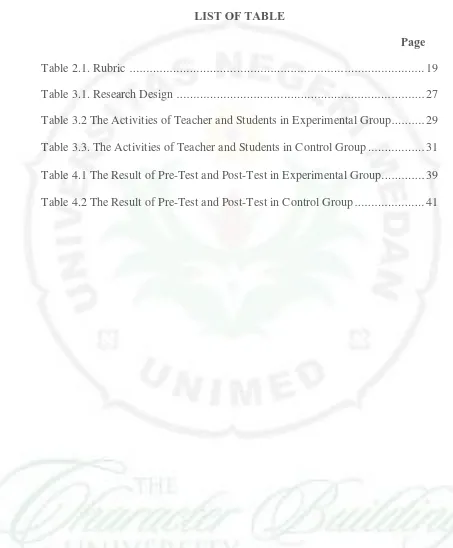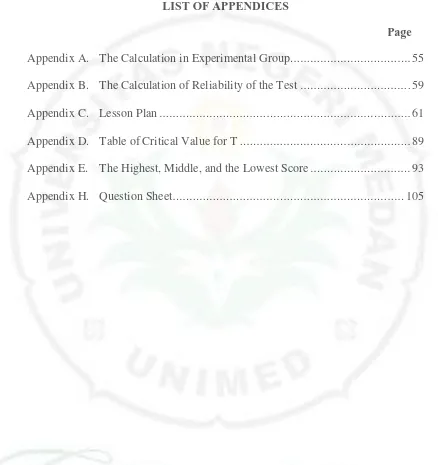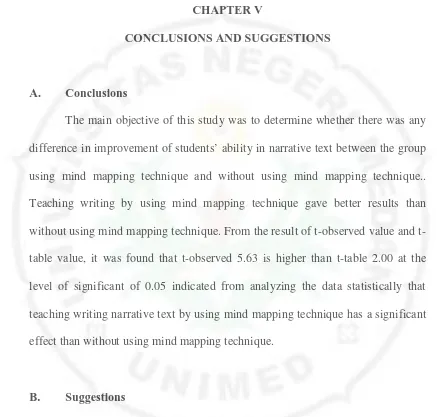THE EFFECT
STUDEN
Submitted for
Re
ENGLISH
FAC
M
ECT OF MIND MAPPING TECHNIQUE
ENTS’ ACHIEVEMENT IN WRITING
NARRATIVE TEXT
A THESIS
tted in Partial Fulfillment of the Requirements for the Degree of Sarjana Pendidikan
By:
FAUZIAH MUHLISA
Registration Number 2111521006
SH AND LITERATURE DEPARTMENT
CULTY OF LETTERS AND ARTS
MEDAN STATE UNIVERSITY
UE ON
G
ts
ABSTRACT
Muhlisa, Fauziah. 2111521006. The Effect of Mind Mapping Technique on Students’ Achievement in Writing Narrative Text. A thesis. Faculty of Languages and Arts, State University of Medan. 2016.
This study deals with the effect of mind mapping technique on students’
achievement in writing narrative text. The objective of this study was to find out if
there was a significant effect of mind mapping technique on students’
achievement in writing narrative text. It was conducted by using experimental research. The population of this study was the eleventh grade students of SMAN 4 Medan which consists of six parallel classes. Two classes were taken as the sample of the research, XI-1 IPA and XI-5 IPA. The class XI-1 IPA was an experimental group and class XI-5 IPA was a control group. The experimental group was taught by mind mapping technique, otherwise the control group was taught by using lecturing technique. The instrument for collecting the data was writing test. The data were analyzed by using test formula. It was found that t-observed (5.63) higher than t-table (2.00). It means that there was a significant
effect on students’ achievement in writing narrative text at SMAN 4 Medan by using mind mapping technique.
ACKNOWLEDGEMENT
First of all, the writer would like to thank ALLAH SWT for giving mercy, blessing, and health to complete this thesis, entitled: The Effect of Mind Mapping
Technique on Students’ Achievement in Writing Narrative Text. This thesis is aimed to fulfill one of the requirements for the degree of Sarjana Pendidikan of The English Department, Faculty of Languages and Arts, State University of Medan (UNIMED).
In completing this thesis, the writer worked with a great number of people, through their guidance, suggestions, and comments and got a lot of assistance and moral support from beloved people. Therefore, the writer would like to express her gratitude and special thanks to:
• Prof. Dr. Syawal Gultom, M.Pd., the Rector of State University of Medan,
• Dr. Isda Pramuniati, M.Hum., the Dean of Faculty of Languages and Arts, State University of Medan,
• Prof. Dr. Hj. Sumarsih, M.Pd.,the Head of English Department, Faculty of Languages and Arts, State University of Medan,
• Dra. Meisuri, M.A., the Secretary of English Department, Faculty of Languages and Arts, State University of Medan, also her Reviewer and Examiner,
• Nora Ronita Dewi, S.Pd., S.S., M.Hum., the Head of English Education Study Program, State University of Medan,
• Dr. Rahmad Husein, M.Edand Tiarnita M.S. Siregar, S.Pd., M.Hum., her Thesis Advisors, for their advice, guidance, kindness, suggestions and precious time during completing this thesis,
• Drs. Johan Sinulingga, M.Pd., her Academic Advisor for his time and good suggestion in completing this thesis,
• Dra. Masitowarni Siregar, M.Ed.,her thesis Reviewer and Examiner,
• All Lecturers of English Department for guidance and advise throughout the academic years.
• Eis Sri Wahyuningsih, M.Pd., the Administration staff of English Deparment, for her attention, assistance, and information in completing this thesis,
• Drs. Ramly, M.Pd., the Headmaster of SMAN 4 Medan and Mrs. Valentina Siregar, S.S., the English teacher who allowed her in doing research in that school.
• Her beloved brothers and sisters Aswin Matondang, Rusli Matondang, Sriyani and Nurannum, for their support and motivation, also for my Matondang big family and Siregar big family,
• A great thanks to the family of Islamic Association of University Student (HMI Komisariat FBS UNIMED) and KOHATI especially the management 2014-2015 periods for the loyalty help her in the period and Atiqah Naisyah, S.Pd., Sri Wahyuni Hsb, S.Pd., M.Hum., Hendri Batubara, S.Pd., Syukri Iskandar Lubis, S.Pd,
• Her bestfriends Miftah, Miska, Holincai, Santy, Karlina, Kak Cipatu, Amel, Siti RahmahandDeny,
• M. Reza Aulia, S.Pt., for his love, patience, moral and financial support and always be there in ups and downs,
• Her special friends Desy Mita Rahmani, S.Pd., Hasanul Arifin Zul, S.Pd., Ratna Sari Siregar, S.Pd., Liliana Dewinta Tarigan, Laura Atikah Sembiring,Pevi Handayani, Sirikit Karola, andArie dwiutami mirza, thanks for solidarity, laugh, ups and downs and unforgettabe moments,
• Her beloved friends in Extension A class 2011, especially Endang, S.Pd andSuma Aini, S.Pd for all of done during more four years in UNIMED. Best of bless and luck.
The writer realizes that this thesis still has the paucity, she warmly welcomes any suggestions, comments, critics, and advices that will improve the quality of this thesis. She hopes this thesis will be useful for those who read and fell interested in the field of this study.
Medan, August 2016 The writer
TABLE OF CONTENTS
A. The Background of the Study...1
B. The Problem of the Study...4
C. The Objective of the Study...4
D. The Scope of the Study...4
E. The Significance of the Study...5
CHAPTER II : REVIEW OF RELATED LITERATURE...6
A. Theoritical Framework...6
1. Students’Achievement in Writing ...6
2. Writing ...7
3. Genre-Based Writing ...9
a. Narrative Text...9
1) Kinds of Narrative ...11
2) Purpose of Narrative ...11
4. Mind Mapping Technique ...14
5. The Assessment of Writing Skill ...17
a. Rubric...18
b. Advantages of Mind Mapping in Teaching English ...21
c. Disadvantages of Mind Mapping in Teaching English ...22
6. The Application of Mind Mapping Technique ...22
B. Relevant of Studies...23
C. Conceptual Framework...24
CHAPTER III: RESEARCH METHOD...27
A. Research Design ...27
B. Population and Sample...27
C. The Instrument for Collecting Data...28
D. Procedure of Research ...28
1. Pre-test ...28
2. Treatment ...28
3. Post-test ...34
E. Validity and Reliability of the Test ...34
1. Validity of the Test ...34
2. Reliability of the Test...35
F. Technique of Data Analysis ...36
G. The Statistical Hypothesis ...37
CHAPTER IV: DATA ANALYSIS AND RESEARCH FINDINGS ...38
A. The Data ...38
B. The Data Analysis...42
C. The Reliability of the Test ...44
D. Testing Hypothesis ...44
E. Research Findings ...45
E. Discussion...45
CHAPTER V: CONCLUSIONS AND SUGGESTIONS ...49
REFERENCES...51
LIST OF TABLE
Page
Table 2.1. Rubric ...19
Table 3.1. Research Design...27
Table 3.2 The Activities of Teacher and Students in Experimental Group...29
Table 3.3. The Activities of Teacher and Students in Control Group...31
Table 4.1 The Result of Pre-Test and Post-Test in Experimental Group...39
LIST OF FIGURES
Figure Page
LIST OF APPENDICES
Page
Appendix A. The Calculation in Experimental Group...55
Appendix B. The Calculation of Reliability of the Test...59
Appendix C. Lesson Plan...61
Appendix D. Table of Critical Value for T...89
Appendix E. The Highest, Middle, and the Lowest Score...93
CHAPTER I
INTRODUCTION
A. The Background of the Study
Writing is one of the important skills in teaching and learning English. It
has occupied in most English language courses, because more and more people
need to learn writing in English for occupational or academic purpose. In order to
write well, people must have good capabilities in writing. The problem is many
students do not know how to write. Siahaan (2008:2) defines writing ability as the
one’s ability to apply the rules of the language of writing, and to transfer the information they have in their mind into the form of paragraphs/text to their
readers effectively The goal of writing is to express ideas or thoughts, so students
should be able to express ideas or thoughts in writing form.
Although Educational Unit Curriculum (KTSP) of Senior High School
issues that the students are expected to be able to write simple paragraph/text of
narrative, procedure, recount, spoof, news item, explanation, analytical exposition,
2
putting ideas into words (Harmer, 2004:11). Students’ failures and problems in
writing are shown by some survey and data. The survey shows that the students’
problem in writing are as follows: limited vocabulary 20%, difficulty in
organizing ideas 16%, no ideas to write about 20%, no motivation to write 20%,
and lack of confidence in grammar 36% (Liu et al, 2007).
In fact, when doing a research in SMA N 4 Medan, the writer found that
learning writing was still in problem. It was proved by the students’ achievement
in writing that was still low. Based on the writer’s research in Grade XI of SMA SMA N 4 Medan, in XI-1 consisting of 48 students, 80% students’ scores in writing skill particularly writing narrative text are under KKM (Kriteria
Ketuntasan Minimum) that is under 70. In XI-5 consisting of 47 students, it is
found that only 30% students get scores 80, even though from both classes 40% of
them are diligent but they are still having difficulties in writing skill . They did not
know how to build sentences that are grammatically correct, had no ideas to
express, and lack of vocabulary, based on the data the writer got after interviewing
the teacher and the students. Therefore, based on the explanation above, it is
necessary for a teacher to do an innovation in teaching to improve students’
achievement in writing.
The appropriate approach, method, technique or strategy can solve the
difficulties of students in writing. One of the appropriate techniques to solve this
problem is mind mapping technique. Mind mapping enables students to be
3
mapping technique, the students are expected to be able to find out the related
words, ideas, concept or questions as many as possible to the topic given. It is
applied by asking the students to make their own mind maps first. Then, they have
to organize the words in their mind maps into a text. Mind map is used in the
pre-writing process for gathering details to create a narrative text. The details are
gained by writing down all the things that are in the students’ mind. The details
will be the material of the text. Then, the students elaborate the details into a
narrative text.
There had been several researches that had ever been conducted on mind
mapping technique and had showed effect to the students’ scores. One research was conducted in SMA N 1 Susukan by Indra (2013). The aim of the research was
to find out the use of mind mapping strategy to improve students’ ability in writing procedure text. The result proved that mind mapping significantly affects
the students writing competencies. Another research was conducted in SMP N 2
Tangerang Selatan by Lutfiah (2011), to see whether mind mapping is an effective
4
By considering the explanation above, this research was conducted to see
the effect of Mind Mapping technique on the students’ achievement in writing,
particularly writing narrative text.
B. The Problem of the Study
The problem of this study was stated as follows: “Is there any significant effect of applying mind mapping technique on students’ achievement in writing
narrative text?”
C. The Objective of the Study
The objective of the study was to find out the effect of mind mapping
technique onstudents’ achievement in writing narrative text.
D. The Scope of the Study
This study was focused on the effect of Mind Mapping Technique in
teaching writing narrative text to the students of grade XI in SMA N 4 Medan. It
5
E. The Significance of the Study
This study was expected to be useful in theoretically and practically.
1. Theoretically, it can be as reference for other researchers who are
interested in doing in the related study, especially in writing
narrative text. They have an understanding about the concept of
Mind Mapping technique.
2. Practically, this study is useful for those who want to apply Mind
Mapping technique in writing narrative text.
a) English teachers will improve students’ writing skill by using
Mind Mapping Technique.
b) Students will apply Mind Mapping Technique when they write
narrative text.
3. Readers, who are interested in dealing with writing narrative text, as
CHAPTER V
CONCLUSIONS AND SUGGESTIONS
A. Conclusions
The main objective of this study was to determine whether there was any
difference in improvement of students’ ability in narrative text between the group
using mind mapping technique and without using mind mapping technique..
Teaching writing by using mind mapping technique gave better results than
without using mind mapping technique. From the result of observed value and
t-table value, it was found that t-observed 5.63 is higher than t-t-table 2.00 at the
level of significant of 0.05 indicated from analyzing the data statistically that
teaching writing narrative text by using mind mapping technique has a significant
effect than without using mind mapping technique.
B. Suggestions
Based on the conclusion above the writer gives some suggestions as the
following,
1. The English teachers are suggested to apply mind mapping technique
to improve the students’ achievement in writing narrative text.
However, teachers need to have creativity and hard work to
implement it. This technique will help the teacher to guide the
50
2. The students, they should practice their writing ability by using mind
mapping technique to help them maximize their writing achievement.
3. The readers who want to do the research to increase the students’
achievement in writing genre, especially writing narrative text by
using mind mapping technique.
4. The other researchers, it is suggested to use this technique in order to
try this study which is very useful for those who are interested in
REFERENCES
Adodo, S. O. 2013. Effect of Mind-Mapping as a Self-Regulated Learning
Strategy on Students’ Achievement in Basic Science and Technology. Mediterranean Journal of Social Sciences Published by MCSER-CEMAS-Sapienza University of Rome, E-ISSN 2039-2117 ISSN 2039-9340, Vol. 4, No. 6
Arikunto, S. 2006. Prosedur Penelitian: Suatu Pendekatan Praktek. Jakarta: PT. Rineka Cipta.
Ary, D. 2006. Introduction to Research in Education.(8th Ed). Sydney: Wadsworth
Best, J.B. and James V.K. 2006. Research in Education. Boston: Pearson Education
Brown, D. 2004.Language Assessment Principles and Classroom Practice. New York: Longman.
Buzan, T. 2008.Buku Pintar Mind Map. Jakarta: PT Gramedia Pustaka Utama.
Buzan, T. 2004.Mind Maps for kids. Jakarta: Gramedia.
Gerot, L., and P. Wignell. 1994. Making Sense of Functional Grammar. Sydney:Gerd Stabler.
Graham, S., & Perin, D. 2007. Writing next: Effective strategies to improve writing of adolescents in middle and high schools – A report to Carnegie Corporation of New York. Washington, DC: Alliance for Excellent Education.
Gultom, E. E. 2012.Improving Students’Achievement in Writing Decriptive Text through Mind Mapping Technique. TRANSFORM Journal of English Language Teaching and Learning of FBS UNIMED Volume 3 no 4
(Accessed on April 24th 2015 from
http://jurnal.unimed.ac.id/2012/index.php/jelt/article/view/1840)
Harmer, J. 2004.How to Teach Writing. London: Longman.
Hornby, As. 2000. Oxford Advanced Learners’ Dictionary of Current English.
London: Oxford University.
52
no 3 (Accessed on April 24th 2015 from
http://jurnal.unimed.ac.id/2012/index.php/eltu/article/view/664)
Hyland, K. 2002.Teaching and Researching Writing. London: Longman.
Hyland, K. 2004. Second Language Writing. New York: Cambridge University Press.
Indra, G. 2013.The Use of Mind Mapping Strategy to Improve Students’ Ability in Writing Procedure Text. Semarang: Semarang State University.
Jaya A.M., Rohmadi A.F. and Ahmad Z.A. 2011. English Revolution. Magelang: El-Rachma Offset.
Jones, B.D., Ruff C., Snyder D.J, Petrich B., and Koonce C. 2012. The Effects of Mind Mapping Activities on Students' Motivation. International Journal for the Scholarship of Teaching and Learning Vol. 6: No. 1, Article 5.
Joyce, H., and Feez, S. (2000).Writing skills: Narrative and non-fiction text types.Sydney: Phoenix Education.
Keleş, Ö. 2012. Elementary Teachers’ Views on Mind Mapping. International
Journal of EducationISSN 1948-5476 Vol. 4, No. 1
Knapp, P., and Watkins, M. 2005. Genre, Text, Grammar. New South Wales: University of New South Wales Press.
Langan, J. 2005. College Writing Skills with Readings, Sixth Edition. New York: McGraw-Hill.
Langan, J.2008.College Writing Skills with Reading. New York: McGraw-Hill
53
Marpaung, A.R. 2012. The effect of Applying Mind-Mapping Technique on the
Students’ Achievement in Writing Descriptive Text. TRANSFORM
Journal of English Language Teaching and Learning of FBS UNIMED
Volume 1 no 2 (Accessed on April 19th 2015 from
http://jurnal.unimed.ac.id/2012/index.php/jelt/article/view/733)
Olivia, F. 2009. Gembira belajar dengan Mind Mapping. Jakarta: Elex media komputindo.
Pardiyono. 2007.Pasti Bisa! Teaching Genre-based Writing. Yogyakarta: Andi.
Patel and Jain. 2008.English Language Teaching (methods, tools, and techniques). Jaipur: Sunrise.
Prayogo, A. 2009.Using Mind Mapping in Teaching Descriptive Writing. Jakarta: Syarif Hidayatullah State Islamic University.
Puspita, R.A., Suwignyo, H., and Karkono . 2013. The Effectiveness of Using Mind Mapping Technique in Writing Short Story Based on Experience Got by the Students Grade IX in SMP Negeri 18 Malang. Malang: Universitas Negeri Malang.
Reid, J.M. 1993.Teaching ESL Writing. New York: Prentice Hall.
Riswanto and Putra. 2013. The Use of Mind Mapping Strategy in the Teaching of Writing at SMAN 3 Bengkulu, Indonesia. International Journal of Humanities and Social SciencesVol. 2 No. 21; November 2012.
Saragih, A. 2008. Discourse Analysis. Medan: State University of Medan. (unpublished
Siahaan, S. 2008.Generic Text Structure.Yogyakarta: Graha Ilmu.
Sihombing, T. H. 2011. Improving students’ achievement in writing narrative by using numbered heads together (nht) technique. Medan: Unimed
Suyanto, A. 2010. The Effectiveness of Mind Mapping to Teach Writing Skill Viewed from Their IQ. Surakarta: Sebelas Maret University.
Syukri, A. 2013. ImprovingStudents’ Achievement in Narrative Writing Through Mind Mapping. TRANSFORM Journal of English Language Teaching and Learning of FBS UNIMEDVolume 2 no 1 (Accessed on April 19th 2015 from jurnal.unimed.ac.id/2012/index.php/jelt/issue/view/216)
54
Tee, T.K., Azman M.N.A., Mohamed S, Mohamad M., Yunos J. Md., Yee M. H. and Othman W. 2014. Buzan Mind Mapping: An Efficient Technique for Note-Taking. International Journal of Social, Education, Economics and Management Engineering, Vol. 8, No. 1.
Wallace, T. 2004.Teaching speaking, listening, and writing. IBE: Geneva. Yelon, Weinstein, & Wiener in http://hmsofyanisnianspd.blogspot/accessed on April, 26th 2015.
(http://www.englishbiz.co.uk) / retrieved on April, 26th 2015.


